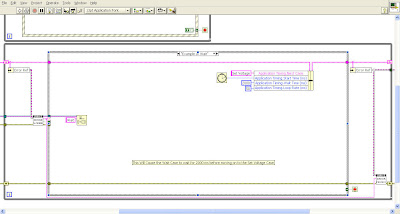By: Todd VanGilder – Project Manager, CLA
Over the years NI has come out with many different hardware platforms including, but not limited to: PXI, CompaqDAQ, CompaqRIO and Modular instruments. However, when dealing with fast scanning high channel count voltage measurements (200 plus) SCXI is still the best option. A matrix/multiplexer module and a modular DMM is another option, but even with the fastest switching modules available this combination cannot compete with the available SCXI solutions; in reference to scanning speed. If accuracy is more important than speed then the DMM/switch option is a viable solution. For the remainder of this article I will focus on determining the correct SCXI devices based on voltage levels, filtering and scanning speed.
Once the SCXI platform has been selected there are still more decisions to be made. There are three 32-channel differential input multiplexer modules to choose from: SCXI-1100, SCXI-1102(B)(C) and the SCXI-1104(C). The first criteria we will be looking at are the maximum input voltages being measured, for this article we will focus only on DC levels. The input voltage range for both the SCXI-1100 and SCXI-1102 is ±10 VDC and both have selectable gains that allow them to accurately measure volt and milli volt sources. The SCXI-1104’s input voltage range is ±60 VDC and has a fixed gain of .1 making it more suitable for mid level voltages, like in automotive applications. However, this does not tell the whole story. Since they are referred to as differential measurement one might be inclined to think that as long as the difference between the CH+ and CH- does not exceed the input range of the device all is good, but this is not the case. Both inputs (CH+, CH-) must remain within the voltage input range of the device in reference to CH GND. For example, if you want to measure the voltage drop across a resistor in series with the 12 volt supply line of a DUT, and you expect the voltage drop will be milli volts, you would not be able to use an SCXI -1100 or the SCXI-1102, since both the high and low side measurement exceed ±10 VDC in reference to CH GND. If the purpose of the previous example is to determine the DUT’s current draw, you have a few options. If possible you could place the series resistor on the ground line of the DUT and use either the SCXI-1100 or SCXI-1102 to determine the current draw. If you are only looking for an indication that the DUT is drawing current you could use an SCXI-1104, the calculated current would not be very accurate since the SCXI–1104 was not designed for milli volt measurements. A third option would be an SCXI-1125, the isolated amplifiers used on the SCXI-1125 can convert a small signal riding on a high common-mode voltage (±300 VDC) into a single-ended signal with respect to the SCXI-1125 chassis ground. The SCXI-1125 only has 8 channels; in a high channel count application this will increase your cost and footprint by a factor of at least 4.
Once you have limited your choices based on voltage the next thing you might consider is the low pass filtering options. If you are measuring DC levels with no interest in the frequency content of the signals the SCXI-1100 has a 4 Hz cutoff filter and the SCXI-1102 and SCXI-1104 have 2 Hz cut off filters. If you are interested in the frequency content of any of the signals then you need to select the appropriate SCXI module. The SCXI-102B has a 200 Hz filter and the SCXI-1102C and SCXI-1104C have 10K Hz filters. The SCXI-1100 cutoff frequency is selectable via jumpers for: no filtering, 10k Hz and 4 Hz. However, the filtering selected for the SCXI-1100 changes the rate at which it switches channels, which affects the effective sampling rate. This leads us to the last consideration we will look at for selecting the correct device, the required sample rate.
Although the SCXI modules are strictly signal conditioning/multiplexing, and the AD is located on the multifunction DAQ card, the sample rate of the AD often is not the limiting factor when determining the effective sample rate of the system. All input channels of the SCXI module are multiplexed (switched) into a single analog input channel of the E/M Series DAQ device. The maximum multiplexing rate of SCXI is 333k Hz. Therefore, if you are scanning 10 channels your max sample rate is 33.3k Hz and with 512 channels (max per DAQ device) 650 Hz would be your max sample rate. If you needed to verify the duty cycle of a PWM signal and you were scanning 512 channels the highest frequency signal you could hope to accurately measure would be about 65 Hz, in order to define the signal with at least 10 data points. Obviously this assumes that the cutoff frequency of the hardware filter of the SCXI module is greater than 65 Hz. The SCXI-1100 scan rates vary with the selected band pass filter as follows: 166k Hz at full bandwidth, 6.6k Hz with 10k Hz filter and 3 Hz with the 4 Hz filter. Both the SCXI-1102(B)(C) and SCXI-1104(C) multiplex at 333k Hz. A combination of multiple DAQ cards and multiple SCXI chassis can be utilized to give the desired scan rates for the number of channels needed in the system. Additionally the SCXI–1125 mentioned earlier can be configured in parallel mode, which allows the use of a different DAQ card for each SCXI-1125 in the SCXI chassis.
There are a lot of factors to consider when selecting the correct analog input device for your system requirements. I have only touched on a few of them in this article. It can be very costly to discover the hardware limitations of your system after the build is complete. I always recommend consulting your NI sales rep or an Alliance partner to help insure that the proper hardware is selected.




